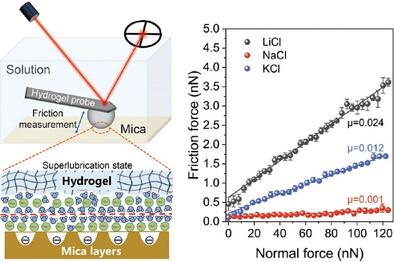Fabrication of AFM-Compatible Hydrogel Probe to Achieve Hydration Superlubrication in Salt Solutions
IF 13
2区 材料科学
Q1 CHEMISTRY, MULTIDISCIPLINARY
引用次数: 0
Abstract
Hydrogels demonstrate effective lubricating properties, but the underlying mechanisms at the nanoscale remain elucidated. In this study, a novel strategy is proposed by fabricating the hydrogel probes compatible with atomic force microscopy (AFM) to establish a superlubrication system based on the hydration interactions. The probe is made of polyethylene glycol diacrylate (PEGDA)-based hydrogel microspheres, which can achieve an extremely low friction coefficient of 0.0014 when sliding on the mica surface in NaCl solution. The friction coefficients in salt solutions sequence μ(NaCl) < 0.01 < μ(KCl) < μ(LiCl), which contradicts the sequence based on the ion hydration capacity (K+ < Na+ < Li+), suggesting that the hydrogel-based lubrication systems are governed by the interplay between ion hydration lubrication and ions-polymer interactions simultaneously. The observed superlubrication in NaCl solution is ascribed to the superior hydration capacity of Na+ ions, which forms a stable and smooth hydration layer within the contact zone. This work provides new avenues for AFM-based hydrogel studies, and also significantly advances the comprehension of hydrogel lubrication mechanisms at the nanoscale

求助全文
约1分钟内获得全文
求助全文
来源期刊

Small
工程技术-材料科学:综合
CiteScore
17.70
自引率
3.80%
发文量
1830
审稿时长
2.1 months
期刊介绍:
Small serves as an exceptional platform for both experimental and theoretical studies in fundamental and applied interdisciplinary research at the nano- and microscale. The journal offers a compelling mix of peer-reviewed Research Articles, Reviews, Perspectives, and Comments.
With a remarkable 2022 Journal Impact Factor of 13.3 (Journal Citation Reports from Clarivate Analytics, 2023), Small remains among the top multidisciplinary journals, covering a wide range of topics at the interface of materials science, chemistry, physics, engineering, medicine, and biology.
Small's readership includes biochemists, biologists, biomedical scientists, chemists, engineers, information technologists, materials scientists, physicists, and theoreticians alike.
 求助内容:
求助内容: 应助结果提醒方式:
应助结果提醒方式:


